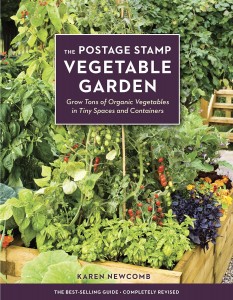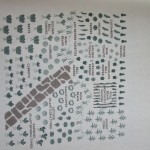The Postage Stamp Vegetable Garden by Karen Newcomb
 What, you say — a gardening book? Who sits down and reads a gardening book? True confession time, I do. This guide turned out to be ideal for my city-small garden and my raised vegetable growing beds.
What, you say — a gardening book? Who sits down and reads a gardening book? True confession time, I do. This guide turned out to be ideal for my city-small garden and my raised vegetable growing beds.
The book opens with this great passage:
It’s a beautiful day. There’s not a cloud in the sky. The temperature is in the mid-80s. And there you are in your backyard, picking loads of vegetables from your own small garden tucked away in the corner of your property. Tomatoes, onions, corn, beans, you’ve grown them all—in fact, more than you ever dreamed possible from such a small space.
Impossible?
Of course not. That’s exactly what a postage stamp garden is intended to do and what you will learn to do in the next several chapters. The techniques outlined here allow you to double or triple the quantities of vegetables you might normally grow in any given space.
First published 40 years ago, in this newly revised edition, Ms. Newcomb introduces us to a radical style of gardening tailored for “postage stamp” or small space gardens. She advocates planting seeds much closer than recommended on the seed packets, with no neat rows and succession plant so you have crops all year round (depending on your location).
She goes on to explain the history of this technique.
The history of this incredible gardening system began in the 1890s. Outside Paris, a few enterprising Frenchmen began raising crops using a new method they discovered. Over their land they spread an 18-inch layer of manure (plentiful in the day of the horse and buggy) and planted their vegetables so close together in this rich material that the leaves touched one another as the plants grew. Under this carpet of leaves, the ground remained moist, warm, and vigorous. During periods of frost, they set glass jars over the tiny plants to give them an early start. So good were the Frenchmen in devising fresh ways of growing things that they were able to produce nine crops a year. Such was the birth of the French Intensive method of gardening, an early form of what we now call intensive gardening.
The benefits of this technique, besides year-round vegetables, are quite attractive — you need less water (key here in California) and it requires less weeding (hear-hear!). Not to say that postage-stamp gardening doesn’t have it’s challenges – it does — but they are clearly and simply explained in this book.
She makes it easy to understand her concept of “crop stretching” — that is, when succession planting in an area that has frost and winter (poor you) you should alternate your crops – early spring planted crops (spinach) are replaced by later crops (beans). Also, if you’ve just harvested slow-growing crops (broccoli) in late summer you now have a short growing season left, so plant a quick maturing crop such as green onions. If your garden is in a temperate climate (like mine) you can plant the same crops in succession all year long (as with lettuce or spinach). She goes on to explain “intercropping” — planting quick maturing crops between slower maturing crops. You harvest the intercrops before the maturing crops have grown big enough to crowd the smaller plants out. That’s getting double duty out of your postage stamp bed.
 The author has given detailed drawings of sample garden layouts, (sorry for the poor photo) there are several designed to fit a 4×4 bed. Look at all the produce! Click to make larger.
The author has given detailed drawings of sample garden layouts, (sorry for the poor photo) there are several designed to fit a 4×4 bed. Look at all the produce! Click to make larger.
The last half of the book is filled with a vegetable by vegetable guide – Ms. Newcomb recommends heirlooms and gives a cute little postage stamp rating (1 to 4 stamps) to indicate which are best for postage stamp gardens. And each section gives crop stretching advice — “you can follow beans with a planting of cabbage…”
There are additional sections covering: Plants That Like Each Other; Herbs; Companion flowers; Composting and Pest Control.
After reading this book, I felt like a beginning gardener all over again. Turns out I’ve been doing it all wrong — plant my vegetables once (or twice) during the year, always in neat rows, thin the small seedlings, and rejoice over what now appears to be very paltry results.
So, if you have a small garden or don’t want the work of a larger one, this is the book for you.
Now, if you’ll excuse me, I have seeds to plant.






Oh, what I wouldn’t give for 4×4 of garden!!!
Oh Katie, I feel your pain.
I’m very lucky, I have four 4×4 raised beds built by my husband and an ex-employee of Mandeville a few years ago. Now after reading and marking up this book – I am going to maximize space and succession plant. No more two or three salads every couple of months – goal is salads only from my garden.